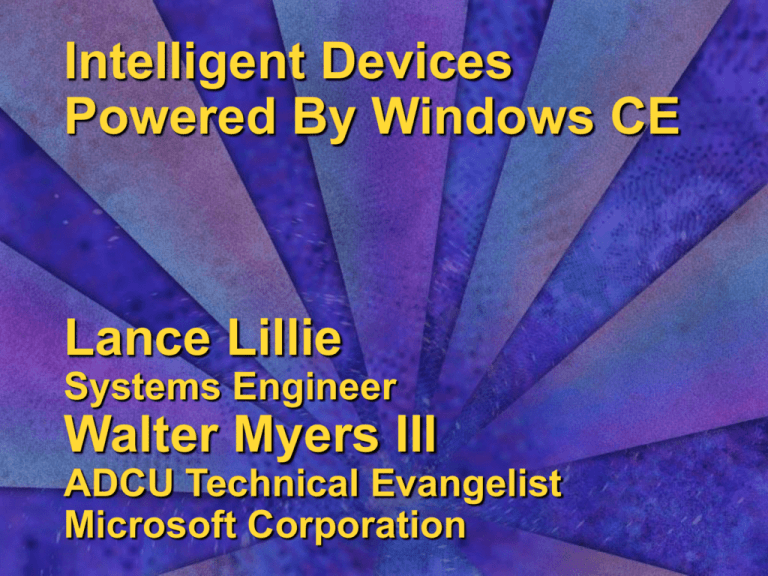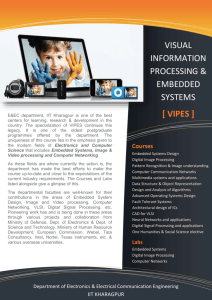Intelligent Devices Powered By Windows CE Lance Lillie Systems
advertisement

Intelligent Devices Powered By Windows CE Lance Lillie Systems Engineer Walter Myers III ADCU Technical Evangelist Microsoft Corporation Agenda Windows CE Platform Digital TV Vertical market/embedded systems devices Handheld PC Palm sized PC Auto PC Q&A Familiar Windows Platform PCs Entertainment and multimedia Mobile Embedded Size and functionality Non-PCs Desktop Laptop NetPC Price and computing power Server And... our Non-PC Arena Strategy Provide familiar, underlying software platform based on industry standards for non-PC devices - the Windows CE operating system Deliver products to enable OEMs, IHVs, and ISVs to develop new categories of devices Build a team of hardware and software support companies Unite the various Windows CE devices Windows CE Designed for intelligent digital appliances Platform to make better devices Vision For Windows CE Access to information Improve communication Entertain Myth: Windows CE is a stripped down version of Windows 95 Reality: Windows CE was built from the ground up using the Win32 API set as a new platform for information appliances Myth: Windows CE equals Handheld PCs Reality: Windows CE is a modular, configurable OS that is the basis for many radically different devices Myth: Java OS is more successful than Windows CE as an embedded system Reality: Over half million Windows CE devices have shipped, over 28 OEMs building products, and an order for 5 million set top boxes from TCI. Java OS design wins have resulted in 1 shipping product (UB networking card). Windows CE v2.0 Designed for wide range of devices Compact, highly-portable, resourceconstrained Provides each device family with appropriate services Applications User interface Connectivity New Device Categories Embedded - vertical handhelds, terminals, industrial controllers, etc. Keys are hardware platforms, development tools, OS performance, “application-specific” developers Mobile market - Handheld/Palm PCs, smaller/larger versions Keys are PC connectivity, ease of use, low power, low cost, applications Large ISV community absolutely critical for success Windows CE Architecture Principles Language-independent, Windows-compatible APIs and programming models Componentized and ROMable for best fit of memory and features Built-in communications to PCs, the Internet, and other Windows CE devices Easy adaptation to many kinds of devices and memory ranges Componentized And ROMable Windows CE systems can be built from the kernel only on up to devices with full kernel, USER, GDI, communications, and shell System can execute in place from ROM or be loaded in or paged in RAM Embedded Toolkit allows maximum flexibility in selecting the right components for a given flatform Enabling Deliverables For OEMs, IHVs, ISVs: Windows CE 2.0 Embedded Toolkit for Visual C++ For ISVs, OEMs, IHVs: Windows CE addin Toolkits for VC, VB, VJ kits new product to spur embedded development Microsoft’s first retail entry into embedded market Familiar development environments for application development More on these later... Our Non-PC Device Initiative Microsoft ISVs Windows CE SDK Internet Windows CEbased devices Applications Windows CE Non-PC device PC Windows CE SDK, DDK, ETK OEMs SI’s, processor partners IHVs Processors Running Windows CE CPU vendor AMD Hitachi Intel Motorola NEC Phillips Toshiba Supported families 46DX5, K6, SC400 (x86 core) SH3 (SH core) 486, Pentium families MPC821 (PowerPC core) Vr4100, Vr4101, Vr4102, Vr4200, Vr4300 (MIPS core) Poseidon (MIPS core) TX3912 (MIPS core) Windows CE Families Of Devices Vertical business Entertainment PC companions Digital Television Received first 5 million unit order for Windows CE in TCI’s Advanced Set Top Box Includes WebTV technologies Vertical Market Devices Radiant Systems Internet mini-kiosk or self-order system DATUS Personal Navigation Assistant PC Companion Line Access information Auto PC Create information Palm PC Handheld PC Synchronized Customizable Expandable PC Companion Products: What You Get Mobility Expandable Instant On Upgradable Look and feel Choice of hardware and software Connectivity Connectivity Anytime, Anywhere Corporate Intranet data E-mail Audio Wired and wireless devices Voice mail Web browsing Fax Calendar Video Internet “push content” Why Wireless Now? Windows CE Products can be wirelessly enabled Wireless Infrastructure In Development and In Place Select Strategic Partners & OEMS Excellent Potential for Windows CE Products to drive other Internal Microsoft Groups Revenue Growth Wireless Architecture •Wireless-enabled new and existing applications •Wireless services allows the user to receive selected information from the Internet and corporate data wirelessly. •Leverages existing information sources Internet, Intranet, Email, etc. •Updates Grab and go information via Mobile Channels H/PC Update Communications Connectivity to Windows desktops, the Internet, and other Windows CE-based devices Supported protocols include TCP/IP, PPP, SLIP and IrDA Subsets of Windows Sockets, Win32 Serial APIs, TAPI, WinInet, Win32 Remote Access APIs Communication hardware is determined by OEMs and IHVs Communications Communications features Secure sockets Wireless TCP/IP improvements SLIP support Ethernet NDIS driver and SMB redirector for LAN connectivity DHCP protocol WinInet for HTTP, FTP IR connection to printers, Windows Installable TAPI Service Providers ActiveSync ActiveX Controls, Visual Basic, And Java Small subset support of the ActiveX Controls (COM/OLE) APIs Java support: In process COM servers, free threaded OLE Inplace between applications OLE Automation, storage API subsetted Componentized Java VM Based on JDK 1.1.1 “Pocket Visual Basic” support: Enables scripting of forms and ActiveX Controls Shells Some Windows CE-based devices will have shells and some will not Many vertical devices may just have a dedicated application H/PC includes a Windows 95, Windows NT 4.0 “look and feel” shell Taskbar, shortcuts, desktop, etc. Remote Connectivity Remote Access APIs provide a Windows desktop with access to Windows CE OS Used to manipulate object stores primarily Transfer files, synchronize databases Remote networking allows for direct connection to PC and dial-up connections to the Internet, PCs, and servers Open synchronization API





